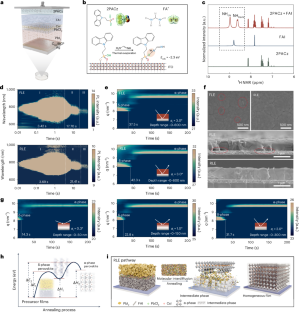Report on Advanced Fabrication of Perovskite Solar Cells for Sustainable Development
This report details a significant advancement in the manufacturing of perovskite solar cells (PSCs) using a fully thermally evaporated process. This innovation directly supports several United Nations Sustainable Development Goals (SDGs), particularly those related to clean energy, sustainable industry, and climate action.
Contribution to SDG 7: Affordable and Clean Energy
The primary objective of this research is to enhance the viability of solar energy, a cornerstone of SDG 7. While thermal evaporation is a well-established technique for scalable and potentially low-cost thin-film manufacturing, its application to PSCs has been limited by performance issues. This work addresses that gap by developing a method to produce highly efficient solar cells, thereby advancing the goal of ensuring access to affordable, reliable, and sustainable energy for all.
Innovation for SDG 9: Industry, Innovation, and Infrastructure
A novel fabrication method, termed the reverse layer-by-layer deposition strategy, has been developed, representing a key technological innovation in support of SDG 9. This strategy improves the industrial potential of PSCs by refining the thermal evaporation process.
Methodology: Reverse Layer-by-Layer Deposition
- The organic precursor, formamidinium iodide, is deposited first.
- The inorganic precursors (CsI/PbCl2/PbI2) are subsequently deposited onto the organic layer.
- A final annealing step is performed to induce crystallization.
Observed Benefits of the Innovative Process
- Controlled diffusion of the solid-phase precursors.
- Enhanced interfacial contact between layers.
- Efficient charge extraction from the active layer.
- Top-down perovskite crystallization, resulting in enhanced vertical uniformity of the film.
Performance Results and Impact on SDG 13: Climate Action
The successful implementation of this strategy has resulted in fully thermally evaporated inverted PSCs with performance metrics that rival those of solution-processed counterparts. These high-efficiency cells are critical for taking urgent action to combat climate change, as outlined in SDG 13, by providing a more effective means of harnessing solar power.
- Peak Efficiency: A power conversion efficiency (PCE) of 25.19% was achieved for a device with an active area of 0.066 cm2.
- Scalability: A PCE of 23.38% was demonstrated on a larger 1 cm2 area, indicating the method’s potential for large-scale production.
Device Stability and Relevance to SDG 12: Responsible Consumption and Production
The long-term operational stability of the fabricated devices is a crucial factor for promoting sustainable production and consumption patterns (SDG 12). Enhanced durability reduces electronic waste and improves the lifecycle of renewable energy infrastructure.
- Operational Longevity: Unencapsulated devices retained 95.2% of their initial PCE after 1,000 hours of continuous operation at the maximum power point.
This high level of stability demonstrates a significant step towards creating durable, reliable, and sustainable photovoltaic technologies.
1. Which SDGs are addressed or connected to the issues highlighted in the article?
SDG 7: Affordable and Clean Energy
- The article focuses on improving the performance of perovskite solar cells, a key technology for harnessing solar power. By reporting higher power conversion efficiencies and operational stability, the research contributes directly to making clean energy more effective and viable, which is the core mission of SDG 7.
SDG 9: Industry, Innovation, and Infrastructure
- The research introduces an innovative “reverse layer-by-layer deposition strategy” for the “scalable fabrication” of solar cells. This represents a technological advancement in manufacturing processes, aligning with the goal of fostering innovation and upgrading industrial capabilities for sustainable development.
SDG 13: Climate Action
- Advancements in solar energy technology are fundamental to combating climate change by providing a clean alternative to fossil fuels. By developing more efficient and durable solar cells, the research supports the broader effort to transition to renewable energy sources, thereby helping to mitigate the impacts of climate change.
2. What specific targets under those SDGs can be identified based on the article’s content?
Targets under SDG 7:
- Target 7.2: By 2030, increase substantially the share of renewable energy in the global energy mix. The article’s focus on improving solar cell efficiency and stability directly supports the goal of making solar energy a more significant contributor to the global energy supply.
- Target 7.a: By 2030, enhance international cooperation to facilitate access to clean energy research and technology, including renewable energy, energy efficiency and advanced and cleaner fossil-fuel technology, and promote investment in energy infrastructure and clean energy technology. This scientific paper is a contribution to the global body of clean energy research, advancing the technology required to meet this target.
Targets under SDG 9:
- Target 9.5: Enhance scientific research, upgrade the technological capabilities of industrial sectors in all countries…encouraging innovation. The article details a novel fabrication technique that improves solar cell performance, which is a direct example of enhancing scientific research and upgrading technological capabilities in the renewable energy industry.
3. Are there any indicators mentioned or implied in the article that can be used to measure progress towards the identified targets?
Yes, the article provides specific technical metrics that serve as direct indicators of technological progress, which in turn contributes to the broader SDG targets.
- Power Conversion Efficiency (PCE): The article explicitly states the fabrication of solar cells with “power conversion efficiencies of 25.19%” and “23.38%”. This is a direct, quantifiable indicator of the technology’s effectiveness in converting sunlight to electricity. Higher PCE is a measure of progress towards more efficient renewable energy technology (relevant to Target 7.2).
- Operational Stability: The article reports that the devices “retain 95.2% of their initial power conversion efficiency after 1,000 h of continuous operation”. This is a key performance indicator for the durability and long-term viability of the solar cells, which is crucial for their practical and widespread adoption.
- Scalability: The mention of a technique for the “scalable fabrication of perovskite solar cells” is a qualitative indicator. It implies that the innovation is not just a laboratory success but has the potential for mass production, which is essential for increasing the share of renewable energy (Target 7.2) and upgrading industrial infrastructure (Target 9.5).
4. SDGs, Targets, and Indicators Table
| SDGs | Targets | Indicators |
|---|---|---|
| SDG 7: Affordable and Clean Energy |
|
|
| SDG 9: Industry, Innovation, and Infrastructure |
|
|
| SDG 13: Climate Action |
|
|
Source: nature.com







